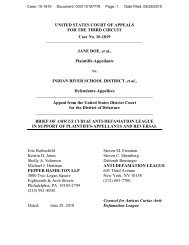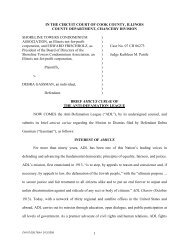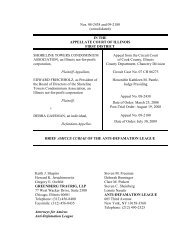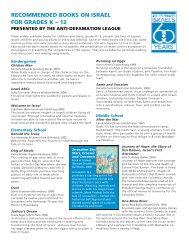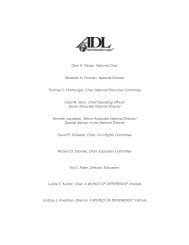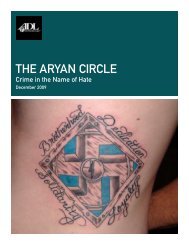101 Ways to Fight Hate Resource Guide - Anti-Defamation League
101 Ways to Fight Hate Resource Guide - Anti-Defamation League
101 Ways to Fight Hate Resource Guide - Anti-Defamation League
You also want an ePaper? Increase the reach of your titles
YUMPU automatically turns print PDFs into web optimized ePapers that Google loves.
End hatred<br />
49. Participate in the National Day of Silence ® , April 25, 2008, which is a student-led day of action<br />
IN YOUR SCHOOL cont.<br />
where those that support making anti –LGBT bullying and harassment unacceptable in schools,<br />
participate in events <strong>to</strong> recognize and protest the discrimination and harassment – in effect, the<br />
silencing – experienced by lesbian, gay, bisexual, and transgender (LGBT) students and their allies.<br />
For more information, go <strong>to</strong> www.dayofsilence.org.<br />
50. Create a student-run Speakers Bureau where students of different backgrounds speak about their<br />
heritage. Identify local and community leaders, civil rights veterans, Holocaust survivors, and<br />
others <strong>to</strong> partner with students in this effort.<br />
51. Apply or encourage students <strong>to</strong> apply <strong>to</strong> ADL’s Grosfeld Family Youth Leadership Mission <strong>to</strong> the<br />
U.S. Holocaust Memorial Museum in Washing<strong>to</strong>n, DC (applications available Oc<strong>to</strong>ber 2007, contact<br />
ADL).<br />
52. Set up a school exchange that brings students from different schools and different backgrounds<br />
<strong>to</strong>gether.<br />
53. Create a calendar with all the holidays and important civil rights dates represented in your school<br />
community. Be sure that important school events (tests, concerts, etc.) do not conflict with religious<br />
holidays.<br />
54. Create an orientation program that addresses the needs of students of all backgrounds so that they<br />
feel welcome when joining the student body.<br />
55. Analyze your textbooks <strong>to</strong> learn how inclusive they are of diverse leaders/pioneers, diverse perspectives<br />
on events, and diverse authors. Present your findings <strong>to</strong> your classmates, teachers, and principal.<br />
56. Encourage the yearbook staff and edi<strong>to</strong>rs <strong>to</strong> devote a section or incorporate pro-diversity and antiprejudice<br />
themes throughout the book by using quotes, headlines, pho<strong>to</strong>s, etc.<br />
57. Participate in No Name-Calling Week January 21-25, 2008, which focuses attention on the problem<br />
of name-calling in schools and provides students and educa<strong>to</strong>rs with the <strong>to</strong>ols and inspiration<br />
<strong>to</strong> continue an on-going dialogue about ways <strong>to</strong> eliminate name-calling in their communities.<br />
For more information, go <strong>to</strong> www.nonamecallingweek.org.<br />
58. Look for examples of youth who have struggled <strong>to</strong> overcome oppression throughout his<strong>to</strong>ry and<br />
create an original dramatic performance piece based on their experiences.<br />
59. Host a Poetry Slam/Open-Mic Night in which students perform original music/poems/raps that<br />
break down stereotypes and promote respect for diversity. Incite community groups, PTA members,<br />
school board members, local businesses, teachers and staff.<br />
60. Work with your school librarian <strong>to</strong> create two separate displays of his<strong>to</strong>rical and contemporary<br />
anti-Semitic and racist publications, including books, newspapers, magazines, films, music, and<br />
videos that expose the continued defamation of the Jewish and African-American population.<br />
61. Research pro-diversity websites, then build a web page for your school and link it others on the<br />
Internet.<br />
62. Meet with food services staff at your school <strong>to</strong> discuss the possibility of featuring ethnic cuisine<br />
on a regular basis. Consult with local restaurants and community groups <strong>to</strong> participate in the<br />
program.<br />
63. Begin learning about and understanding other cultures though literature, art exhibitions and<br />
onsite learning programs that bring cultures alive.<br />
64. Construct a multimedia display that examines how <strong>to</strong>day’s media perpetuates stereotypes.<br />
Review current films, television sitcoms, music, and advertising campaigns, in addition <strong>to</strong> newspapers,<br />
magazines and books.<br />
65. Research peace negotiations going on around the world regarding ethnic or racial conflict. Then<br />
stage a mock summit in which students portray international leaders who try <strong>to</strong> resolve these<br />
crises.<br />
66. Request that a student-faculty committee establish an annual Diversity Day when regular classes<br />
are suspended and community members and leaders are invited <strong>to</strong> speak on and explore<br />
diversity with students. Consult ADL <strong>to</strong> plan the program (314.432.6868).<br />
Imagine<br />
68. READ and research newspapers/magazines about current immigration issues, then compare<br />
67. Ask the local lesbian/gay/bisexual/transgender (LGBT) center, theater group or organization <strong>to</strong><br />
speak or perform at your school.<br />
what more we<br />
could do...<br />
current debates with debates and immigration policies of the past. Invite a speaker that recently<br />
went through the immigration process <strong>to</strong> speak about his/her experience.<br />
69. Ask your librarian <strong>to</strong> collect samples of popular teen magazines/comic books from around the<br />
world and request a special corner be set aside for them in the periodical room.<br />
8 9



